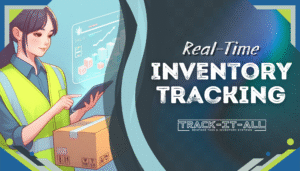You’re sitting at your desk, surrounded by a sea of notifications, a never-ending to-do list, and the constant buzz of distractions. Sound familiar? You’re not alone. In today’s fast-paced work environment, maintaining productivity can feel like trying to catch a butterfly in a storm. But fear not! We’ve got your back.
Welcome to our productivity powerhouse! In this blog post, we’ll unlock 20 practical ways to supercharge your workday, boost your focus, and achieve peak performance. Whether you’re battling email overload, drowning in tasks, or yearning for that elusive work-life balance, we’ve got strategies that work.
Hey there! We’re the productivity enthusiasts at Track-It-All. Our mission? To help you thrive in the workplace, one tip at a time. Let’s dive in!
Time Management Techniques
- Time Blocking: Imagine your day as a well-organized calendar, each moment allocated to a specific task. That’s time-blocking! You set aside dedicated chunks of time for different activities. By doing this, you tame the chaos, enhance focus, and make your day predictable. It’s like having a personal assistant guiding you through tasks, one block at a time. Benefits include increased productivity, reduced multitasking, and less stress.
- Pomodoro Technique: Picture a tomato-shaped kitchen timer (yes, that’s where the name comes from!). Work for 25 minutes (a “pomodoro”), then take a 5-minute break. Repeat. After four pomodoros, enjoy a longer break. This method improves concentration, minimizes distractions, and prevents burnout. It’s like interval training for your brain, helping you stay sharp and efficient.
- Eisenhower Matrix: Inspired by President Dwight D. Eisenhower, this matrix categorizes tasks into four quadrants based on urgency and importance.
- Quadrant 1 (Important and Urgent): Handle these tasks immediately—crises, deadlines, or pressing issues.
- Quadrant 2 (Important but Not Urgent): Prioritize these for long-term goals—planning, self-improvement, and strategic thinking.
- Quadrant 3 (Urgent but Not Important): Beware of distractions—emails, notifications, and minor tasks. Delegate if possible.
- Quadrant 4 (Not Urgent and Not Important): Avoid these time-wasters—mindless scrolling, unnecessary meetings, and busy work.
Productivity Tools and Apps
1. Task Management Apps
When it comes to staying organized and boosting productivity, task management apps are your secret weapon. Consider these popular options: . Trello is a versatile project management tool that allows you to organize tasks, collaborate with team members, and track progress all in one place. Another popular option is Asana, which offers powerful features for managing team tasks and projects. By utilizing these task management apps alongside effective HR management strategies, you can streamline workflow, improve communication, and ultimately increase productivity within your organization.
- Trello: Visualize your tasks on boards, lists, and cards. Collaborate seamlessly with your team and keep track of progress.
- Asana: Streamline project management, assign tasks, and set deadlines. Asana helps you stay on top of your to-do list.
- Todoist: Prioritize tasks, set reminders, and create subtasks. It’s like having a personal assistant for your productivity.
2. Note-Taking Tools
Digital note-taking apps revolutionize the way you capture ideas and information. Here are the benefits of using them:
- Evernote: Organize notes, web clippings, and images. Access your digital brain from anywhere.
- OneNote: Sync notes across devices, collaborate with colleagues, and annotate PDFs effortlessly.
3. Calendar Apps
Effective calendar management is crucial for productivity. These popular choices can help you stay on track:
- Google Calendar: Schedule meetings, set reminders, and integrate with other tools seamlessly.
- Outlook Calendar: Manage appointments, share availability, and stay organized within your email client.
So, the right tools can transform your workday, boost efficiency, and help you achieve peak performance. Choose wisely and watch your productivity soar!
Workspace Optimization
1. Declutter Your Workspace
A tidy and organized workspace can work wonders for your productivity. When your desk is clutter-free, your mind feels clearer, and you can focus better. Here’s why a clean workspace matters:
- Positive Impact: A clutter-free environment reduces stress and helps you feel more in control. When everything has its place, you can quickly locate what you need, saving time and mental energy.
2. Ergonomics: Set Up Your Workstation Comfortably
Invest time in creating an ergonomic setup. Consider these tips:
- Chair and Desk Height: Adjust your chair and desk so that your feet rest flat on the floor, and your arms form a 90-degree angle when typing. Proper alignment prevents strain and discomfort.
- Monitor Placement: Position your monitor at eye level, about an arm’s length away. This minimizes neck strain and ensures better posture.
- Keyboard and Mouse: Keep them close to your body, with your wrists straight. Use a wrist rest if needed.
3. Minimize Distractions
Staying focused is crucial for productivity. Try these strategies:
- Notifications: Turn off non-essential notifications during work hours. They can disrupt your flow and pull you away from tasks.
- One Task at a Time: Multitasking may seem efficient, but it often leads to decreased productivity. Focus on one task, complete it, and then move on.
- Short Breaks: Taking short breaks rejuvenates your mind. Set a timer for every 25-30 minutes and step away from your desk. Stretch, hydrate, or simply breathe.
Optimizing your workspace isn’t just about physical surroundings; it’s about creating an environment that supports your work and well-being. Implement these changes, and watch your productivity soar!
Mindset and Habits
1. Goal Setting:
Setting clear and achievable goals is like charting a course for productivity. When you define your objectives, you create a roadmap that guides your efforts. Break down larger goals into smaller, manageable tasks. Prioritize these tasks to stay on track and celebrate each milestone you achieve. Remember, a well-defined goal is a powerful motivator.
2. Mindfulness and Meditation:
Amid the hustle and bustle of work, take a moment to breathe. Mindfulness and meditation help you center yourself, reduce stress, and enhance focus. Practice deep breathing or try short meditation sessions during breaks. These simple practices can boost your mental clarity and overall well-being.
3. Healthy Habits:
Your physical health directly impacts productivity. Prioritize sleep, nutrition, and exercise. Lack of sleep can lead to decreased productivity, so aim for quality rest. Fuel your body with nutritious meals and stay hydrated. Regular exercise not only keeps you fit but also sharpens your mind. Remember, a healthy body supports a productive mind.
Communication and Collaboration
Effective Communication:
Clear and Concise Strategies When it comes to productivity, effective communication is a game-changer. Here are some strategies to ensure your messages hit the mark:
- Start with Clarity: Before you speak or write, know what outcome you want. Are you seeking agreement, decision-making, or simply an attentive ear? Be explicit about your intentions.
- Consider Your Audience: Tailor your communication to your listener’s needs and perspective. Acknowledge their viewpoint, especially if they might be resistant or facing challenges.
- Organize Your Thoughts: Chunk your information into clear segments. Use an A-B-C approach. For instance, when discussing a raise with your boss, outline why you deserve it while acknowledging financial concerns.
- Cut the Jargon: Avoid buzzwords and technical language. Instead of saying your “bandwidth is full,” simply state that your schedule is packed.
- Use Short, Direct Sentences: Put the subject at the beginning of your sentence. Be concise and to the point.
Collaboration Tools:
Slack and Microsoft Teams Both Slack and Microsoft Teams enhance team collaboration. Here’s a quick comparison:
- Slack: Known for simplicity and ease of use. Ideal for smaller teams and external collaborations. Offers a range of features and integrations.
- Microsoft Teams: Comprehensive and robust. Part of Office 365. Great for large organizations, schools, and government. Provides video options and deep integration with other Microsoft tools.
Delegation:
Empowering Your Team Delegating isn’t just about lightening your load; it’s about growth and efficiency:
- Builds Trust: Trust your team to handle tasks. It fosters a positive culture.
- Prevents Burnout: Distributing responsibilities prevents overload and stress.
- Optimizes Resources: Allocate tasks effectively, ensuring everyone’s skills are utilized.
- Empowers Team Members: Delegation encourages ownership and skill development.
Therefore, effective communication, collaboration tools, and smart delegation are your shortcuts to a more productive workday!
Dealing with Burnout at the Workplace
The End
Boosting your productivity at work doesn’t require a complete overhaul; small changes can yield significant results. Remember these 20 ways to increase your productivity: prioritize tasks, delegate when possible, minimize distractions, and focus on one task at a time. Short breaks can rejuvenate you, and automating repetitive processes saves time. Your workspace matters—keep it organized. And don’t forget to take care of yourself; lack of sleep can hurt productivity. As the saying goes, “Work smarter, not harder.” Implement these strategies, and watch your work performance soar.
“Productivity is never an accident. It is always the result of a commitment to excellence, intelligent planning, and focused effort.” – Paul J. Meyer







